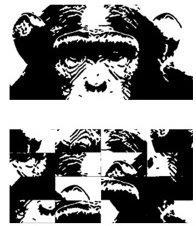Human success stems from our social groups. By working together we can achieve more than we ever could hope to individually. In fact, the benefits of group life are so profound that they’ve shaped the course of our biological evolution. Our large brains, for example, evolved in part to help us remember lots of people and relationships, allowing us to live in bigger and better groups.
Group life has also left its evolutionary mark on our psychology as well. Humans are very susceptible to peer pressure and the watchful eyes of others. This vulnerability to peer pressure is so strong that even cartoons of eyes watching us can make us less likely to cheat. In fact, images of eyes reduce the level of cheating even more than a strongly worded sign saying “don’t cheat.”
Carefully placed eyes can even reduce the rate at which people litter, increase the likelihood they’ll leave the correct amount of money for their purchases in an unsupervised shop and increase the rate at which they follow recycling rules. But what’s perhaps most interesting is that people in these experiments don’t report even noticing the eyes, or feeling under extra pressure. This is all going on at a subconscious level.
The eyes say “subscribe to EvoAnth”
In short, those who behaved correctly when being watched by other members of their group flourished as they weren’t being thrown out of groups for being nasty. This spread this trait throughout the population through natural selection until we all had an innate, subconscious response to seeing eyes, even if they were cartoon, that makes us more likely to follow the rules.
Chimps are our closest living relatives and also live in large complex groups. These groups also appear to have shaped their evolutionary history and so, like humans, they’re vulnerable to peer pressure and so are less likely to misbehave when being watched by others. For example, low ranking chimps are less likely to try and take food if being watched by others in their group.
But are they as susceptible to peer pressure as humans? Are images enough to make them follow the rules? To test this, scientists created a similar experiment to the ones used in humans. They presented a chimp with some peanuts that, by rights, should belong to the dominant male. They then either put up a picture of another chimp or a neutral image and watched to see if the chimps would take the food anyway.

Chimps were either presented with the face of another chimp (top), or the freaky muddled up face (bottom)
Unlike humans, chimps took the food in every test; even when shown an image of another chimps. Low ranking chimps tended to hesitate a bit when the face of another chimp was visible, but still ate the dominant male’s peanuts! Clearly chimpanzees are pure evil, the blankness of their fur matched only by the blackness of their hearts. It also indicates that, unlike in humans, their susceptibility to peer pressure is not strong enough for them to be influenced by mere images of rule enforcers (Nettle et al., 2013).
This means that they hyper-susceptibility seen in humans evolved at some point within the last 7 million years since we split from chimps. We can probably narrow this down to within the last 2 million years, as it’s only since then that our social groups have become larger and more complex than chimps (Dunbar, 1993).
Some may count it as a victory for those damn dirty apes that they’re capable of figuring out a picture isn’t real and thus can’t hurt them if they misbehave. On the other hand I can’t help wonder if the ease with which people can be bullied into behaving is one of the reasons our society has been so successful.
References
Dunbar, R. 1993. Coevolution of neocortical size, group size and language in humans. Behavioural and Brain Sciences, 16: 681-735
Nettle, D., Cronin, K. A., & Bateson, M. (2013). Responses of chimpanzees to cues of conspecific observation. Animal Behaviour.

